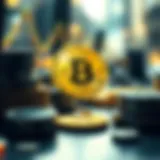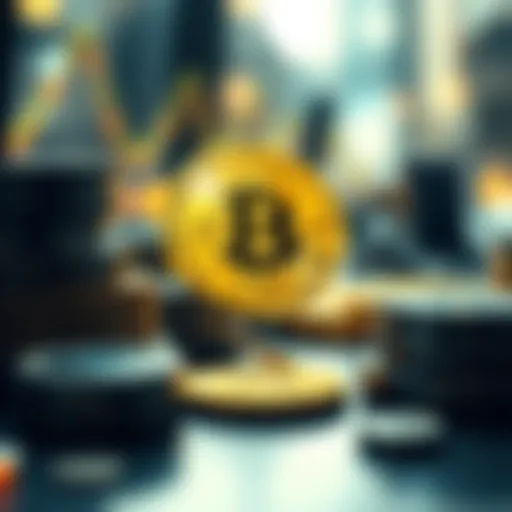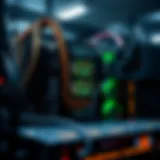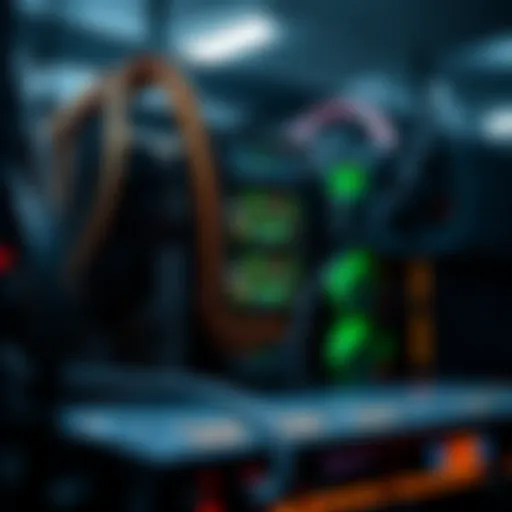Choosing the Best Platforms for NFT Art Creation
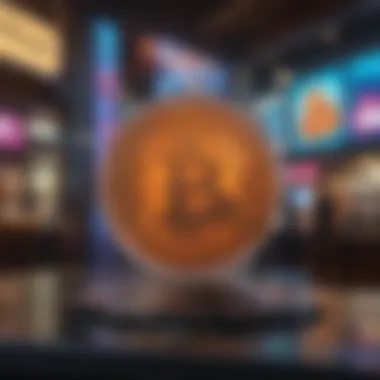

Intro
In recent years, the art world has been shaken up by the advent of non-fungible tokens (NFTs). This digital revolution has opened new avenues for artists, bringing their work into the crypto space and potentially increasing their market reach. However, with countless platforms available for NFT creation and sales, navigating this digital landscape can be as confusing as a cat in a room full of rocking chairs. It’s not just about throwing a piece of art onto the blockchain; it's vital to choose the right platform to maximize visibility and sales.
The journey we’re embarking on here delves into the landscape of NFT art creation. We will parse the unique features of various platforms, examine their usability, and unpack the socioeconomic factors that influence the NFT marketplace. Moreover, we’ll investigate how blockchain technology plays a pivotal role in this space, providing artists with tools they need to make informed choices. Throughout this exploration, community engagement will also be underscored as a crucial element for success in this evolving market.
So, let’s roll up our sleeves and dive into the nitty-gritty of contextualizing these platforms within the larger framework of NFT art creation.
Crypto Concepts Explained
Before diving deeper, it's necessary to build a foundational understanding of some of the key concepts in the NFT and blockchain world. Knowing these terms can guide artists and enthusiasts alike on what to look for in the right platforms.
Key Terminology and Definitions
- Non-Fungible Token (NFT): A digital asset that represents ownership of a unique item or piece of content, secured via blockchain. Unlike cryptocurrencies such as Bitcoin or Ethereum, NFTs cannot be exchanged on a one-to-one basis, as each carries distinct information.
- Smart Contract: A self-executing contract with the terms of the agreement directly written into code. In the context of NFTs, smart contracts govern the buying, selling, and transfer of ownership.
- Marketplace: Platforms where NFTs are bought and sold. Each marketplace has its own unique features, audience, and fee structures.
- Blockchain Technology: The underlying tech powering cryptocurrencies and NFTs. It is a decentralized ledger that enhances security and transparency in transactions.
Practical Applications of Blockchain Technology
The artistic landscape is no longer confined to galleries and exhibitions. Blockchain technology provides artists with tools to sell directly to collectors without reliance on intermediaries. Some applications include:
- Direct Sales: Artists can list and sell their work directly on platforms like OpenSea or Rarible, keeping a larger share of the profits.
- Royalties: Smart contracts allow creators to earn royalties from secondary sales, ensuring ongoing revenue from their work.
- Provenance Tracking: Each NFT is linked to its digital signature, tracking ownership history and validation of authenticity with ease.
"With the rise of blockchain technology, artists have the opportunity to reclaim control over their works and revenue streams, a significant shift from traditional art markets."
Investment Strategies
For artists delving into NFTs, understanding investment strategies is equally vital. Knowing how to navigate market trends and manage risks can be the difference between a flourishing career and a flop.
Analyzing Market Trends and Indicators
Artists should pay attention to the current trends in the NFT space. Some useful indicators include:
- Sales Volume: Following the high-volume sales of certain projects can signal popular trends worth exploring.
- Community Engagement: A highly engaged community often translates into better marketability for NFT artworks.
- Emerging Technologies: Keeping an eye on new tech innovations within blockchain can provide early access to potentially lucrative platforms or protocols.
Risk Management Techniques
- Diversification: Like any investment, spreading your work across various platforms decreases the risk of losses.
- Research: Always look into the platforms’ fee structures, user experiences, and community sentiments before committing.
- Stay Informed: Regularly following industry news can assist in making educated decisions about upcoming shifts.
Understanding NFT Art
The realm of NFT art encapsulates a unique blend of creativity and technology. As artists increasingly turn to digital canvases, the significance of comprehending the intricacies of NFT art becomes essential. It’s not just about creating art; it's about grasping how to navigate the waters of this innovative marketplace where traditional boundaries of ownership and distribution are being redefined.
Why does understanding NFT art matter? For one, it equips artists and collectors alike with the knowledge to make informed decisions. Delving into the specifics enables creators to optimize their artworks for digital sale and ensures collectors recognize the underlying value beyond mere aesthetics.
Defining NFTs
At their core, Non-Fungible Tokens (NFTs) act as unique certificates of ownership for digital items housed on the blockchain. Unlike cryptocurrencies such as Bitcoin or Ethereum, which are interchangeable and can be traded on a one-to-one basis, NFTs are distinct. Each token carries specific information that distinguishes it from another, maintaining irreplaceability. This uniqueness is what allows them to represent digital art, music files, or even virtual real estate.
One important aspect to note is that NFTs are not inherently tied to the digital asset—they are merely a record or proof of ownership. For instance, an artist creates a stunning digital painting and mints it into an NFT. The token may exist on a blockchain like Ethereum, allowing buyers to purchase it, yet the original digital file remains accessible to anyone. This shift in perspective invites deeper questions about value and ownership in the digital age.
Unique Characteristics of NFT Art
Few art forms come with the unique characteristics that define NFT art. Among these, scarcity stands as a paramount feature. Artists can decide how many copies of their artwork exist in the digital realm. Limited availability can drive demand, setting up a compelling market dynamic that mirrors more traditional art sales.
Another key feature is the potential for provenance. Every transaction involving an NFT is recorded on the blockchain, creating an unalterable ledger. This transparency not only assures buyers of the authenticity of an artwork but also provides a verifiable history of ownership.
Moreover, the concept of interactivity can emerge. Many artists leverage NFT capabilities to embed dynamic elements or unlock additional content for buyers. This includes behind-the-scenes footage or even future artworks, fostering a richer experience for collectors. Buying an NFT can sometimes be more like acquiring a subscription to an ongoing relationship with an artist than it is about singular ownership.
The Role of Blockchain Technology
Blockchain technology forms the backbone of the NFT ecosystem. It ensures security, transparency, and decentralization, characteristics that were lacking in traditional art markets. Artists can create, buy, and sell without intermediaries, maintaining more control and receiving a larger share of their sales.
Additionally, blockchain verifies authenticity and ownership without requiring a trusted third party. Whenever an NFT is bought or sold, the whole process is recorded on the blockchain, an open ledger that anyone can consult.
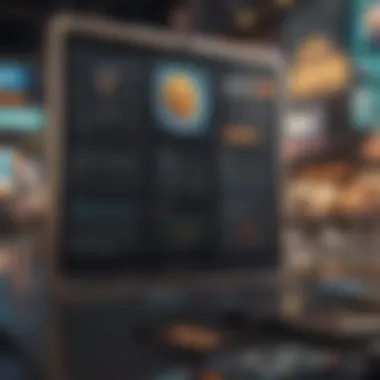

This raises an interesting point. Traditional artworks can sell for millions, yet their ownership often rests in the hands of galleries or auction houses. In contrast, creators of NFT art can connect directly with their audience, broadening their reach and cultivating a dedicated following. It's a game-changer for the art world.
"Understanding the intersection of blockchain and art isn't just about technology; it's about redefining how we perceive value, ownership, and community in artistic endeavors."
Given these factors, it's clear that grasping the nuances of NFT art is essential. Artists and collectors who can navigate this digital landscape effectively stand to benefit immensely. Understanding NFT art isn't just an academic pursuit; it's a gateway to engaging with a community and market that continues to evolve at a rapid pace.
Key Considerations for Artists
When venturing into the realm of NFT art creation, artists face a multitude of decisions that can shape their success in the digital marketplace. Each choice, from technical skills required to understanding marketplace dynamics, is pivotal. The landscape is rife with opportunities, yet it can be just as daunting. Therefore, grasping these key considerations not only empowers artists but also arms them with the knowledge to navigate potential obstacles with confidence.
Technical Skills and Requirements
Having a solid footing in technology is essential for artists engaging in NFT creation. While the barriers have lowered over time, a basic proficiency in digital drawing tools and understanding of blockchain are indispensable.
- Digital Creation Tools: Familiarity with software like Adobe Creative Suite, Procreate, or Blender is vital. These platforms enable artists to bring their visions to life in a digital format that can be minted as NFTs.
- Blockchain Knowledge: A grasp of how blockchain operates is crucial. Artists should understand how NFTs are minted, traded, and sold. This knowledge translates to better decisions about where to host their work.
- Adaptability to Platforms: Each NFT platform has its own set of technical specifications. Being versatile and willing to learn means artists can choose the one that aligns with their style and technical skills.
- Adobe Photoshop and Illustrator are favorites among artists for their versatility and range of features.
- Blender offers an open-source platform ideal for those interested in 3D art.
- Basic concepts such as wallets, transactions, and ERC-721 token standards should be on every artist’s checklist.
Artwork Preparation and Format
Preparing artwork for the NFT marketplace is more than just slapping it onto a platform; it encompasses a variety of strategic decisions that will impact visibility and desirability.
- File Formats: It’s critical to be aware of acceptable file formats on different platforms. Most commonly accepted formats include JPG, PNG, GIF, MP4, and even audio files. Ensuring compatibility can prevent unnecessary headaches during the minting process.
- Resolution Matters: High-resolution images not only look better but also exhibit a sense of professionalism. Aim for the highest quality possible while keeping performance in mind. Larger files can lead to slower loading times which might deter potential buyers.
- Adding Details: Some platforms allow for additional elements like unlockable content or expanding metadata. This feature can enhance the value of the NFT and provide buyers with more than just a static piece, making it more appealing.
Understanding Gas Fees
Gas fees, the transaction costs on blockchain networks, are an aspect that artists often overlook but are crucial to the NFT experience. These fees can fluctuate significantly based on network congestion and must be planned for accordingly.
- What Are Gas Fees?: Simply put, gas fees are payments made to miners for processing transactions on the blockchain. Each time an artist mints or sells an NFT, they will incur these fees.
- Dynamic Pricing: On Ethereum-based platforms, for instance, gas prices can balloon during peak activity times. Thus, understanding when to transact is critical to minimizing costs. Tools like EthGasStation can help artists monitor these fluctuations.
- Cost Calculations: Before diving headfirst into minting, it's prudent for artists to estimate their gas expenses to ensure profitability on sales. Keeping a budget for these fees can prevent cash flow issues down the line.
“Being financially savvy about the oscillating costs related to minting NFTs is an invaluable skill for modern artists.”
Overall, these key considerations are foundational in establishing a resilient presence in the NFT art world. Paying attention to technical skills, preparation of artwork, and understanding financial nuances collectively contribute to an artist's potential success.
Popular Platforms for Creating NFT Art
Navigating the world of NFT art requires a thorough understanding of the various platforms available to artists. Each platform is designed with unique features tailored to different needs, from simple minting processes for beginners to complex ecosystems for experienced creators. In an era where digitization of art is transforming traditional markets, knowing the right place to showcase and sell one’s work can significantly impact success.
The significance of these platforms lies in their capabilities to connect artists with potential buyers, offering not just tools for creation, but also an audience that appreciates and values their work. The choices made during the selection process can determine how well an artist’s creations are received, making it essential to weigh the advantages and disadvantages of each option.
OpenSea
User Interface and Experience
OpenSea's user interface is often lauded for its simplicity and intuitiveness. For many artists, a clean and accessible dashboard means less frustration. The key here is that it's user-friendly enough for newcomers while providing deeper features for seasoned users. One unique aspect is its robust search functionality, enabling artists to categorize and tag their work efficiently. This tool helps users find specific types of art quickly, enhancing the chance of visibility. However, some users might face a slight learning curve if they are looking for advanced features hidden within its menus.
Ecosystem Connectivity
One of OpenSea’s standout features is its excellent ecosystem connectivity. It collaborates with numerous wallets and platforms, allowing for seamless transactions and interactions. This extensive connectivity not only broadens the potential market for creators but also enhances their credibility. Artists can easily link their profiles to other social media and crypto wallets, making sharing their work a breeze. The flipside is that such extensive connectivity might overwhelm users new to the NFT space, who may not yet be familiar with all the linked tools available.
Market Exposure for Artists
Market exposure on OpenSea is substantial thanks to its high traffic volume and established user base. Its diverse catalogue means that art from all genres can coexist, increasing the likelihood of attracting buyers from varying interests. The platform often features new artists, which can lead to increased visibility and sales. On the drawback, standing out amidst thousands of listings can be tough, requiring artists to actively engage in marketing and promotion beyond what the platform itself offers.
Rarible
Community Governance
Rarible is distinguished by its community governance model, which allows users to influence platform developments through vote-based systems. This aspect fosters a sense of ownership among creators, making it a favored choice for those who appreciate being involved in key decisions. The specific feature of RARI tokens enables artists to participate in governance while also earning rewards for their contributions. However, for some creators, the complexities of governance could be seen as a barrier, as it requires understanding blockchain-based voting mechanisms.
Rewards and Royalties
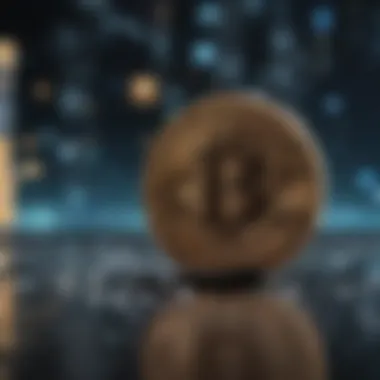

With Rarible, artists can create varying royalty structures that ensure they receive a percentage of future sales of their work. This feature is particularly appealing for artists envisioning long-term relationships with their collectors. The transparent nature of royalty settings can build trust between artists and buyers. However, users must maintain diligence, as miscommunication about these royalties can lead to disputes or confusion down the line.
User-Friendly Minting Process
The minting process on Rarible is designed to be straightforward, inviting artists who might be intimidated by the more technical aspects of NFT creation. The simplicity of uploading an artwork and establishing listing terms stands out, encouraging diverse creators to join the platform. That said, the ritual simplicity can be seen as a double-edged sword, as seasoned users might crave more nuanced control options that aren't available.
Mintable
Ease of Use for Beginners
Mintable prides itself on its approachability for those just entering the NFT arena. Newcomers can easily upload their artwork, set prices, and list items for sale with minimal fuss. The essential aspect here is the intuitive layout, which demystifies the process of minting NFTs. However, while it's great for beginners, the same simplicity can sometimes limit advanced features that more experienced users may seek as they grow in their digital art journey.
Royalty Structures
Mintable offers customizability in royalty structures, allowing artists to define clear terms specifying how much they will earn from future sales. This financial incentive can be a deciding factor for many artists, fostering a supportive environment for creators. Yet, it is crucial to read the fine print, as different tiers of service can influence how these structures are implemented, potentially complicating an otherwise straightforward process.
Minting Options and Costs
The minting options on Mintable cater to various needs, from free minting processes that attract newcomers to paid forgery options that offer advanced features. This blend makes it an appealing choice for both budget-conscious artists and those willing to invest for better looks. However, the cost of minting can vary substantially, causing confusion if not clearly communicated, leading to unexpected fees post-listing.
Foundation
Curated Marketplace
Foundation curates its offerings, featuring high-quality artwork chosen by community votes, which can elevate an artist's profile significantly. This curated approach guarantees a semblance of exclusivity, attracting collectors who seek out premium works. The downside here may be that aspiring creators could find it challenging to get noticed in a more selective marketplace. Only a fraction of submissions may see the light, creating a left-out feeling among some.
Artist Community Engagement
The platform excels in promoting community engagement, allowing artists to interact with one another and collectors. This active participation enhances the network aspect of NFT trading, giving creators a chance to build relationships. However, the level of active engagement required could be a deterrent for those preferring a more autonomous experience, potentially leading to burnout for some.
Best Practices for Submission
Foundation provides guidelines on best practices for submitting work, educating creators on high-quality presentation and optimal tagging. Following these practices can increase chances for visibility and sales. That said, strict adherence to these practices may not resonate with all artists, who prefer a more free-spirited approach to showcasing their work.
Nifty Gateway
Collectible Drops
Nifty Gateway stands out due to its collectible drops, which create excitement around limited edition releases. The anticipation built around these drops often leads to increased demand, benefitting artists by amplifying their reach during launch periods. On the flip side, the frenzy surrounding collectible drops can be overwhelming for both buyers and artists, occasionally causing disappointment when their pieces are sold out too quickly.
Partnerships with Established Artists
The platform has developed strong partnerships with established artists, catapulting new artists into broader visibility through collaborations. These high-profile associations can enhance credability and attract collectors looking for valuable pieces. However, the focus on well-known artists may overshadow emerging talent, potentially making it difficult for newer creators to get noticed.
Integration with Traditional Payment Methods
Nifty Gateway allows users to purchase NFTs using credit cards, a feature that attracts a wider audience unfamiliar with cryptocurrencies. This integration broadens access and makes it easier for traditional art collectors to venture into NFTs, reducing barriers to entry. Still, the reliance on standardized payment methods could limit interactions within the crypto community, where cryptocurrency is the norm.
Evaluating Platform Features
When considering an engaging NFT art creation experience, evaluating platform features becomes paramount. Artists must grasp how tools, interfaces, and the community can affect their creative journey and financial success. A platform’s features—ranging from user-friendly interfaces to substantial community engagement—directly influence an artist’s reach and effectiveness in this ever-evolving digital landscape.
User Experience and Interface Design
A well-designed user interface can either make or break an artist’s relationship with a platform. It's essential to prioritize intuitive navigation and accessibility. The importance of user experience cannot be overstated. When an artist grapples with a clunky interface or a maze of menus, their focus shifts from creativity to frustration.
Moreover, the aesthetics of the platform itself play a significant role. A visually appealing layout not only enhances usability but can also inspire artists. For instance, platforms like Rarible are designed with vibrant visuals that engage users right from the outset. Their color schemes and layouts are not just attractive but also conducive to seamless interactions.
In addition, responsiveness to user feedback is a critical factor. Platforms that adapt and evolve their interface based on artist experiences cultivate loyalty and trust. Thus, ensuring a smooth UI and user-centric design leads to enhanced productivity, allowing artists to concentrate on what they do best: creating art.
Community and Networking Opportunities
Community is the lifeblood of NFT platforms. Much like a bustling marketplace, the right platform can foster connections between artists and collectors. Platforms that emphasize community engagement help artists network with peers, gain visibility, and receive constructive feedback.
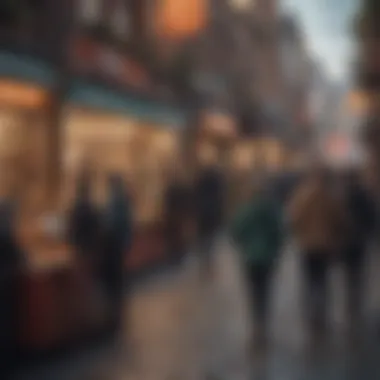

Getting involved in forums, social media groups or even platform-hosted events can lead to valuable relationships. Community features, like forums or social channels, allow artists to exchange ideas and experiences, essentially serving as a creative incubator. For instance, OpenSea hosts forums where artists and buyers can discuss trending art styles, which opens doors for collaboration and mutual growth.
Furthermore, platforms that support collaboration over competition—such as curated drops or collective exhibitions—encourage camaraderie among artists. It creates a convivial atmosphere that benefits everyone involved, as new artists can learn from seasoned creators.
Support and Resources for Artists
Having access to quality support and resources can drastically ease the transition into the NFT space. When artists are equipped with information about minting, royalties, and pricing strategies, they can make informed decisions that positively impact their careers.
Platforms that offer tutorials, webinars, and customer service are showing they care about their artists' success. Having a responsive support team can resolve hiccups quickly, allowing artists to focus on their art rather than administrative concerns. Moreover, educational resources about the NFT ecosystem, blockchain technology, and market trends are crucial for navigating this complex world.
The availability of mentorship programs can also be invaluable. Platforms that connect emerging artists with established creators foster a sense of belonging and skill development. In essence, comprehensive support helps demystify the NFT process for artists, allowing them to thrive in this dynamic field.
"Evaluating platform featuresisn't just about choosing a space to showcase art; it's about choosing a community that cultivates growth and creativity."
By examining these crucial aspects of platform features, artists can understand where to invest their time and talents, making their journey through the NFT world smoother and more rewarding.
Promoting NFT Art
In the world of NFT art, simply creating a piece doesn't guarantee that it will find its audience. Promoting NFT art is essential for artists who want to enhance their visibility and reach. This process encompasses various strategies aimed at elevating an artist's profile and drawing attention to their creations. A well-executed promotion can make the difference between an overlooked piece and a celebrated masterpiece that sells for a small fortune.
Building an Artist Brand
The first step in promoting NFT art is to build a distinct artist brand. Your brand should clearly convey who you are as an artist and what you stand for. This involves consistent themes and styles in your art, paired with a relatable biography that connects with potential buyers.
- Establish a Unique Voice: Every artist needs a voice. This voice should reflect your ideas and emotional connections within your pieces. Clearly articulated values can resonate with collectors who share those beliefs.
- Visual Consistency: Your visual style is your signature. It should be recognizable across various platforms and pieces. Using consistent colors, themes, or motifs can help reinforce your brand identity.
- Engagement with Followers: Building a brand isn't a one-way street. Engage with your audience through comments, feedback, and collaborations. These interactions not only humanize the artist but also create a community that supports your work.
Effective Marketing Strategies
Once the brand is established, effective marketing strategies come into play. Artists must possess a toolset of promotional tactics to navigate the crowded NFT landscape.
- Email Marketing: Crafting newsletters to announce new drops, share developments, or discuss artistic inspirations fosters a sense of intimacy with followers.
- Cross-Promotion: Seek collaborations with other artists or influencers. By playing in the same sandbox, both parties benefit from shared exposure to each other's audiences.
- Virtual Exhibitions: Hosting online events or galleries can showcase collections in a curated manner. This not only adds polish but also creates buzz around your work.
"Marketing is no longer about the stuff that you make but about the stories you tell." – Seth Godin
Leveraging Social Media Platforms
Social media stands as the juggernaut of promotion in the digital age and for NFT art, it's invaluable. Each platform boasts unique attributes beneficial for artists.
- Instagram: Known for its visual nature, it's perfect for artists to showcase snapshots of their work, behind-the-scenes creating processes, and personal stories that engage potential buyers.
- Twitter: This platform is beneficial for real-time interactions and updates on NFT trends. Artists can chime in on trending topics, connect with collectors, and establish relationships with other creators.
- Discord: Many NFT communities thrive here. Joining groups related to art or specific NFT platforms allows artists to network, gather feedback, and stay updated on market dynamics.
- Reddit: Subreddits focused on NFTs and art can be great places to share insights and showcase work. However, authenticity is crucial; the community values genuine engagement over self-promotion.
By developing strong promotional strategies and actively engaging with different platforms, NFT artists can ensure that their work does not become a hidden gem in a sea of creations. As the NFT landscape continues to evolve, adapting to these strategies is essential for sustained visibility.
Future of NFT Art Creation
The realm of NFT art creation stands at a pivotal juncture, teetering between revolutionary potential and nascent technological hurdles. Understanding the trajectory that this field of digital creation is likely to take is essential not only for artists but also for investors, analysts, and tech developers who seek to navigate this intricate landscape effectively. The future holds the promise of expanded accessibility, enhanced interactivity, and even more diverse ways to engage with art and its creators.
Evolution of Platforms
As the digital landscape continues to shift, NFT platforms are not sitting still either. They are evolving to meet the demands of an increasingly sophisticated audience. Many platforms currently offer a user-friendly interface but are beginning to integrate features that cater directly to artists. For example, some of these platforms are experimenting with augmented reality, allowing users to experience art in a three-dimensional space.
Moreover, an emphasis on eco-friendliness is gaining traction. In response to the environmental concerns surrounding blockchain technology, platforms are exploring more sustainable practices. This includes shifting to proof-of-stake mechanisms or utilizing layer-two solutions that reduce energy consumption. Changes like these not only benefit the environment but can also attract artists and collectors who are mindful of their carbon footprints.
Impact of Emerging Technologies
New technologies are poised to create dynamic shifts within the NFT space. Blockchain improvements, such as scalability of transactions and enhancements in security protocols, are paving the way for broader widespread acceptance. Smart contracts, which enable automatic royalty payments for resale, have already transformed how artists earn from their works, and continued advancements in this area will only enhance artists' ability to monetize their creations.
Additionally, the integration of Artificial Intelligence into NFTs can provide unique opportunities for interactive art. AI algorithms might allow for artworks to change based on viewer interaction or environmental stimuli, thus breathing new life into traditional notions of artistry. As these technologies mature, they present innovative avenues for NFT creations that engage audiences in unprecedented ways.
Trends and Predictions for the NFT Market
Looking towards the horizon, various trends are emerging that can guide investors, analysts, and artists alike. First, the democratization of art ownership is becoming increasingly pronounced. More affordable options and fractionalized ownership models are making it possible for a broader audience to partake in the ownership of digital art.
Second, collaborations between artists and brands are likely to intensify. Major brands have already started to dip their toes into the NFT waters, and it is anticipated that partnerships will create hybrid art forms that blend traditional marketing with digital innovation. This trend could give rise to an entire genre of NFT art that resonates with both art enthusiasts and commercial enterprises.
Lastly, there is a growing focus on authenticity and provenance, as counterfeiting poses a significant risk in digital environments. NFT platforms will need to adopt better verification procedures to reassure artists and buyers that their purchases are legitimate.
"The NFT market isn't merely a trend; it's a fundamental shift in how we perceive and engage with art and ownership."
The future of NFT art creation is set to be as colorful as the artworks themselves. By staying attuned to these shifting sands of technology and market trends, stakeholders can better position themselves to seize opportunities in this burgeoning field.




